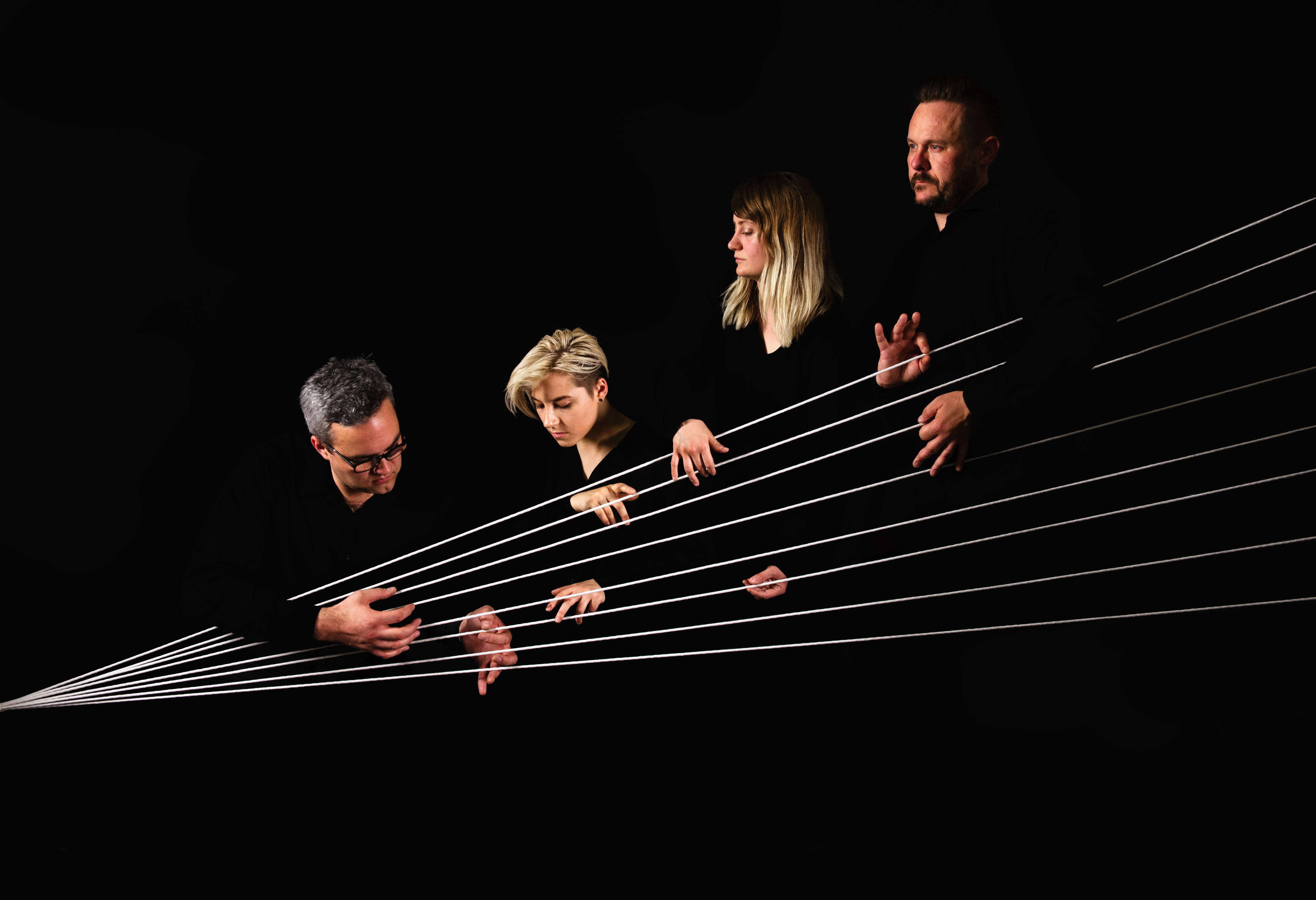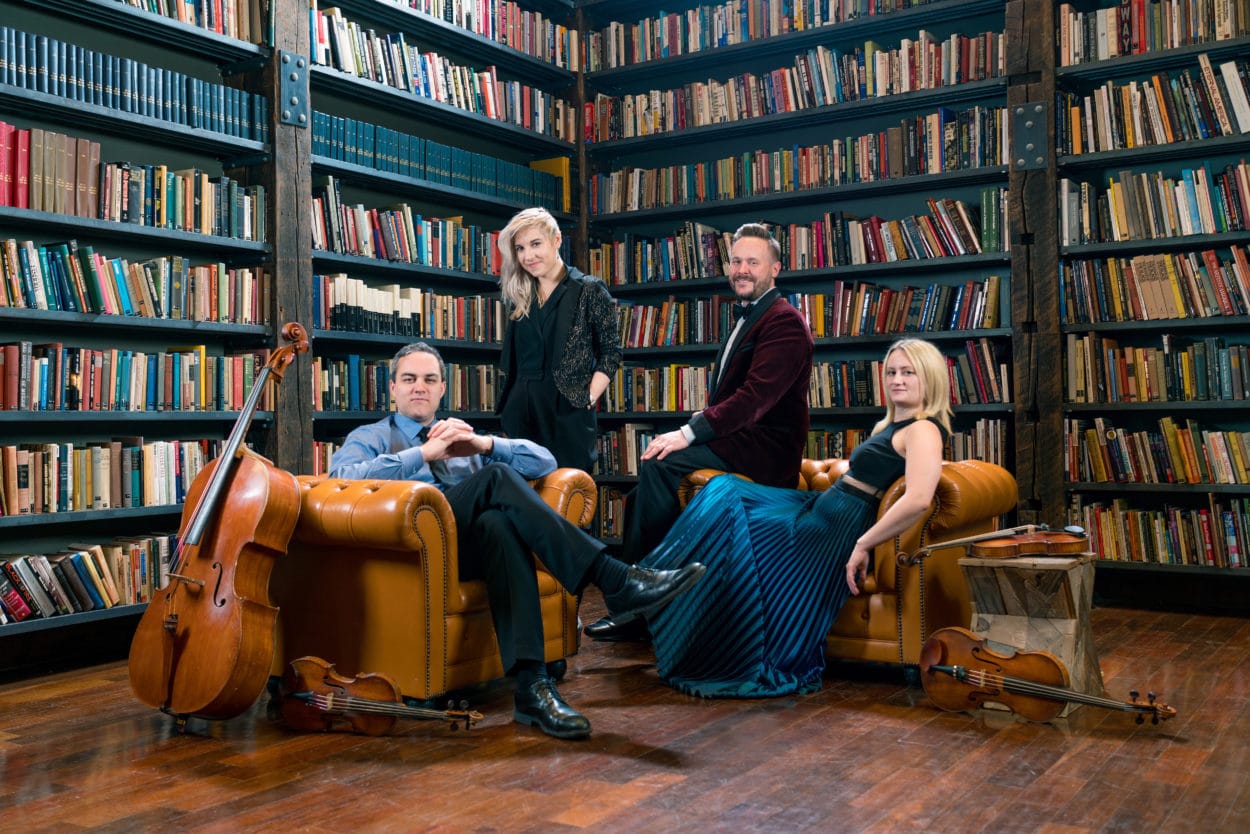
There was a time when I needed the cash, so I substitute taught high school. Turns out I had a knack for helping resistant young minds to focus. The key to getting my students where they needed to go was to shift, not lower, expectations. I would ask them, what did they think themselves capable of and why? Then I would challenge them to prove it. The goal needn’t be found in the formal rubric, just something we could both agree upon as constructive. The results were nearly always positive.
I thought of that last night as I listened to the Spektral Quartet’s program, Looking Skyward at the Kennedy Center’s Terrace Theater.
Building to the finale – the world premiere of Enigma by Icelandic composer Anna Thorvalsdottír and video artist, Sigurður Guðjónsson, co-commissioned by Spektral and Washington Performing Arts – among others, the Chicago-based string quartet began in the 16th Century with their own arrangement of O magnum mysterium, a sacred work originally composed for voice by Tomás Luis de Victoria. Next was another commissioned work, American composer Eliza Brown’s String Quartet No. 1, followed by a late string quartet by Beethoven, the Op. 135.
Each work on its own presents a challenge for listeners accustomed to tidy measures that resolve as centuries of listening to Western musical form has taught us to expect them to. But if the listener drops these expectations, there is much to be gained.
The program notes written by Spektral violist Doyle Armbrust stated that in our moments of extreme joy or frustration, when we tip our heads skyward, our cultural conditioning is to consider that as lifting our eyes to heaven. But what does heaven actually represent, Armbrust wonders. He does not know, but concludes it is the question, not the answer that matters.
“You do not need any specialized knowledge to come to these works,” Armbrust further encouraged the audience in between the Brown and the Beethoven. “However you choose to encounter the music, that is the way to do it.”

Thus instructed, I took my critical notes throughout, aware of the artists’ explicit trust in the audience to “get it”, even if the works at first seemed challenging, especially on a night when the hometown team was playing in Game 6 of the World Series, and the house was full of fans itching to thumb their phones to check the score.
When the time came for the post-performance discussion of the evening’s performance, here’s what I had learned: I got it.
The Victoria piece began after the stage lights were dimmed: A single note, bowed long and slow by violinist Maeve Feinberg. I was confused at first. Was she the concertmaster and the others would soon tune in? No. It was the foundation for a simple but powerful architecture built by successive notes aimed at heaven, a song without its original Latin, still redolent with prayer.
In the silence that followed, the lights now up, the quartet slowly conjured a torrent of astro-weather, again confusing me at times: was that a clarinet? How does a cello make that sound? Such aural surprises made it difficult to feel grounded with the rushing runs and evocative lines that surfaced in the high strings before the low ones submerged where I had located the piece’s direction. Each gust of notes led me to question if I had just been where I thought I was and whether I would end up there again.
For the Beethoven, the quartet left plenty of space for the composer’s central question to ring: “Must it be?” Beethoven wrote on the score to his sixteenth string quartet, the Op. 135, his last complete work before his death. The space Spektral created between the notes played alternately between the high and the lower strings in the final movement were longer than I think audiences in Beethoven’s time would have been comfortable with, were longer than maybe today’s audience knows how to cross. For me, their daring to pause between notes was what I love most about music: it shapes the space between. Between what? Everything. Notes, sounds, the next thing, one another.
“It must be,” Beethoven concluded, writing again on his score.
Spektral’s performance of the work was beautifully rendered, the entire piece played sweetly and earnestly. The effect was more that of a celestial conversation between instruments as proxies for their players, than successive bars of notes, however virtuously played.
In an interview, Thorvalsdottír described her collaboration with Guðjónsson on Enigma as a musical exploration of the “in-between light and dark.” The visual and musical effect on me was to feel longing and horror simultaneously. Her many percussive and pizzicato notes sounded lunar and spacy while Guðjónsson’s monochromatic blobs of what looked like living sea coral upset me, making me desperate to break free of the watery depths. Ultimately, the effect was so overpowering, I closed my eyes and only listened.
The work’s tonal center is a melancholy call that is not answered until at last in the final bars, when the tonic is thankfully completed. When Spektral expertly landed Thorvalsdottír’s musical spaceship back on earth, I was relieved that I would not be left alone to deal with the sadness the work had provoked. Even if I couldn’t tell you what my ache was, it was now resolved.
In my notes, I had written: surprise, relationship, the new defines the old, unresolved, question.
These same words or ones like them were used during a question and answer time with the quartet.
It would seem, all of us, including Beethoven, got “it”, whatever “it” is.
There is a larger lesson for those of us who love classical and contemporary music, and also for those who seek to learn but are intimidated. It is that standard expectations matter because they give us a starting point. But, as I found with my students, when formal expectations become the default for what an experience is supposed to be, the impulse to engage with our own minds is suppressed, and we miss the chance to be challenged, and so rewarded with surprise and wonder.
Worse, we miss an opportunity to trust that we will get where we need to go, even if we take a path others do not.
Especially if we take that path.
Running Time: 90 minutes including one 20-minute intermission.
Looking Skyward was performed by The Spektral Quartet at the Kennedy Center’s Terrance Theater, and was sponsored by Washington Performing Arts. For more information on Spektral Quartet, go online.





“The effect was more that of a celestial conversation between instruments”. I loved this line! I loved this performance and experienced awe and wonder throughout. Not to mention amazement at the skill and artistry of the musicians. Truly an out of this world performance!
Thanks for your comment! That’s great to hear.